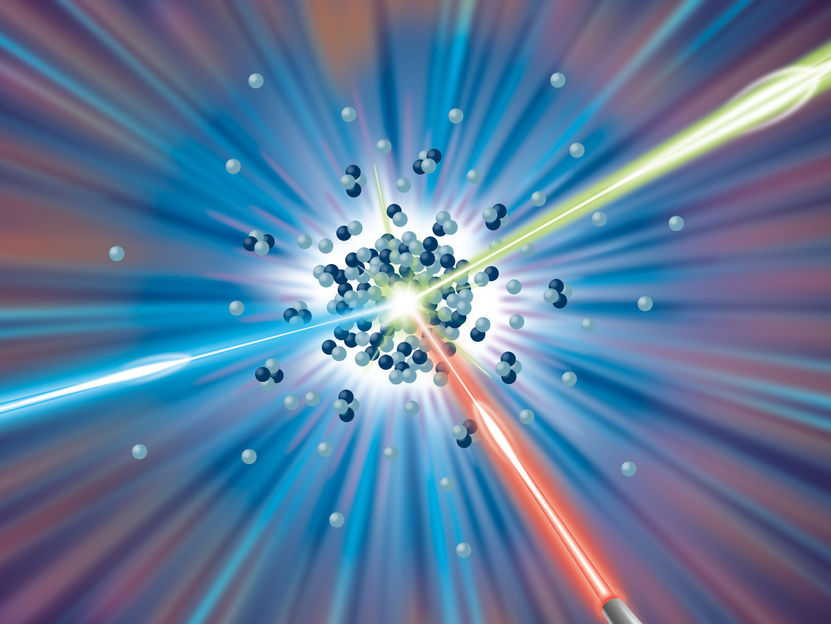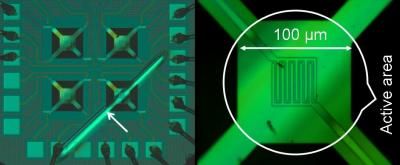Precise X-ray thermometer for warm dense matter
New method for temperature determination opens horizon for a multitude of experiments virtually unfeasible up to now
Advertisement
Warm dense matter (WDM) measures thousands of degrees in temperature and is under the pressure of thousands of Earth's atmospheres. Found in many places throughout the universe, it is expected to have beneficial applications on Earth. However, its investigation is a challenge. Even the temperature of a material under WDM conditions is anything but easy to determine. A team of researchers led by Dr. Tobias Dornheim from the Center for Advanced Systems Understanding (CASUS) at HZDR has demonstrated a mathematical solution that allows an accurate assessment of the temperature.

Schematic of the setup of an ICF experiment.
CASUS/Blaurock
As the team points out in the journal Nature Communications, their method can readily be used at experimental facilities of matter research around the world and expedite the gain of scientific knowledge.
The investigation of WDM primarily serves the understanding of planets and stars. But there are other reasons experts are trying to recreate such states of matter with elaborate experiments on Earth: Novel materials with fascinating properties are just as conceivable as significant advances for inertial confinement fusion (ICF), a promising method of energy generation.
In the laboratory, WDM can currently be generated for fractions of a second using powerful laser flashes. But the evaluation of these experiments is time-consuming and hinders the basic understanding of what WDM is and how it behaves. X-ray scattering has emerged as a promising method of measurement. Besides the lasers that generate the warm dense matter, an additional X-ray laser is directed at the sample. Depending on how its light is scattered as it passes through the sample, conclusions can be drawn about the properties of the material. This so-called X-ray Thomson scattering is evaluated by simulations or models. However, neither variant is very accurate since certain assumptions must always be made to obtain results. Simulations, in particular, are also very resource-intensive, and researchers need access to the world's largest supercomputers to run them. The evaluation of experiments has therefore been a bottleneck for scientific progress.
"We demonstrate with our work that it is possible to evaluate the scattering data without using simulations or models and all their approximations and assumptions," says Dr. Tobias Dornheim, first author of the study and leader of the Young Investigator Group "Frontiers of Computational Quantum Many-Body Theory" at CASUS. "We don't reproduce experiments but extract the temperature directly from the measurement. This reduces the effort of evaluating experiments with WDM many times over. Our method is also significantly more precise than relying on simulations and models. Interpreting the results is simple and straightforward." Dornheim and his team base their approach on a fundamental mathematical procedure, the Laplace transform. Using three examples, they demonstrate that their method allows unbiased temperature determination of WDM. The actual materials studied, and the experimental facility from which the scattering data originate are of minor importance. The proposed property determination, also called diagnostics, is universally applicable and does not require the use of supercomputers.
A typical CASUS project
"This new approach shows that you can sometimes accomplish a compute-intensive task faster and better by simply thinking differently about the complex question at hand," says Dr. Michael Bussmann, Scientific Head of CASUS. "This publication exemplifies the path we've taken with CASUS: rethinking data-intensive research of complex systems across individual disciplines."
"We are confident that our method will be adopted by experimental physicists and is helpful to them when they evaluate their work," adds Dornheim. One field that could potentially benefit is fusion energy research. Here, attempts are being made to replicate on Earth processes that take place in stars. In ICF, for example, fuel made of deuterium and tritium is extremely heated and compressed; an intermediate state is the WDM. X-ray scattering is used to monitor this process closely.
Decisive element in fusion energy research
A recent announcement from the National Ignition Facility (NIF) at Lawrence Livermore National Laboratory (LLNL) in the US gave the field of ICF a major boost. For the first time, a fusion ignition succeeded at NIF in which more energy was produced by the fusion reaction than energy was provided by the lasers to start the reaction. CASUS doctoral student Maximilian Böhme conducted research at NIF for six months at the turn of 2018/19. As second author of the new publication, he contributed significantly to the development of the approach. "The fusion experiments at NIF also use X-ray scattering to measure the temperature. And the team there is struggling with exactly the same shortcomings of available diagnostics. Fast and accurate temperature determination is definitely a crucial element that will take fusion energy research a big step forward. And it’s exactly that element we are now providing with our work," Böhme reckons.
In addition, the new method is useful for experiments in laboratory astrophysics for which the Helmholtz International Beamline for Extreme Fields (HIBEF) at the European XFEL is used. Some of these experiments are intended to improve our understanding of the many planets currently known outside our solar system and to test whether life might be possible on one of them.
In collaboration with Dr. Tilo Döppner (LLNL), Dr. Thomas Preston (European XFEL), and Prof. Dominik Kraus (University of Rostock and HZDR) - all experimental physicists and co-authors of the current publication - Dornheim and his team now intend to show that their method also allows to draw conclusions about other WDM properties beyond temperature in a precise and straightforward manner.


































































